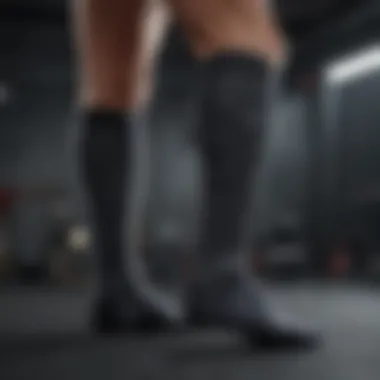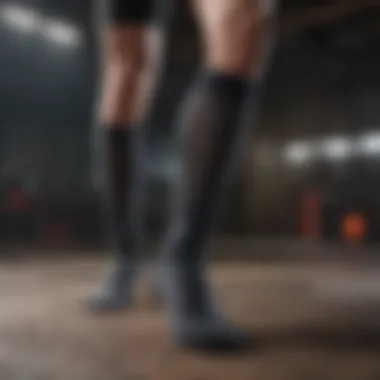Top Rated Compression Socks to Enhance Circulation


Intro
Compression socks have moved from the realm of specialized medical use to a staple in many people's wardrobes. Their role in improving circulation can't be overstated. Whether you're a nurse on your feet for long shifts, an athlete looking to boost recovery, or someone who simply wants to feel good and prevent discomfort, compression socks may offer a solution. These socks are designed to apply gentle pressure to the legs and feet, enhancing blood flow and reducing swelling.
In this guide, we will cover the mechanics behind compression therapy, the wide array of designs available in the market, and a selection of top-rated products that cater to different needs. For those interested in their benefits, we will explore how these socks work and provide insights from experts in the field. By the end of this read, you’ll have a solid understanding of how compression socks can become an integral part of your health regimen.
Workout Tips
Finding the right balance in physical activity helps amplify the effects of compression socks, making workouts more effective and enjoyable. Here are a few pointers:
- Integrate Cardio Exercises: Activities such as brisk walking, cycling, or jogging improve blood circulation and complement the benefits of wearing compression socks. Consider adding intervals to keep it interesting and boost your heart rate.
- Muscle Strengthening Techniques: Exercises like squats, lunges, and calf raises not only build strength but also enhance circulation in the legs. Remember, the stronger your muscles, the better blood flow you will have.
- Incorporate Yoga and Stretching: Engage in yoga poses like downward-facing dog and legs-up-the-wall. Not only do these poses promote relaxation, but they can also facilitate improved blood flow, essential for those wearing compression socks.
Regular movement and exercise can play a key role in your overall wellness. Here’s a brief view:
- Choose workouts that you can commit to.
- Mix in both cardio and strength elements.
- Ensure proper hydration and nutrition to fuel your sessions.
"Incorporating compression socks into your fitness routine can elevate your performance while helping you recover faster. They are allies in both exertion and rest."
Nutrition Advice
Optimizing your diet can augment the effects of compression therapy. Foods rich in antioxidants and vitamins can aid in circulation and overall wellness. Here's how to enhance your diet:
- Balanced Meals: Aim for meals that include lean proteins, whole grains, healthy fats, and plenty of vegetables. A well-rounded plate helps sustain energy levels during and after physical activities.
- Fuel with Healthy Foods: Foods such as bananas, spinach, and nuts are excellent for providing essential nutrients that support muscle function and vascular health.
- Sample Meal Plans: Plan your meals around your schedule. Consider a simple meal plan that includes:
- Breakfast: Oatmeal with berries and nuts.
- Lunch: Grilled chicken salad with a variety of colorful vegetables.
- Dinner: Baked salmon with quinoa and steamed broccoli.
Managing nutrition wisely can only help you harness the full benefits of wearing compression socks.
Wellness Insights
Compression socks serve a practical purpose, but the path to wellness doesn't end there. Other strategies can contribute greatly to managing stress and embracing overall health:
- Stress Management Techniques: Explore mindfulness practices such as meditation, deep breathing exercises, or journaling to cultivate mental clarity and ease.
- Mind-Body Practices: Activities like tai chi or mindful walking foster a sense of balance and inner peace, complementing the physical benefits of compression socks.
- Self-Care Routines: Make it a habit to take time for yourself. Create a schedule that includes daily or weekly self-care rituals, whether it's a long bath, reading a book, or spending time outdoors.
Latest Trends
Compression technology is evolving continuously, with new advancements and research emerging regularly. Keeping up with these trends can help you stay informed:
- New Technologies: Look out for socks featuring graduated compression or moisture-wicking materials that could enhance comfort during use.
- Recent Studies: Recent research highlights the effectiveness of compression therapy in reducing delayed onset muscle soreness, making them increasingly popular in sports recovery.
- Upcoming Workshops: Follow health and wellness blogs or local community boards to find workshops or seminars that delve deeper into the use of compression garments in various fields such as sports medicine, physical therapy, and overall wellness.
Understanding Compression Socks
Compression socks might seem like just a piece of clothing, but they play a significant role in maintaining and improving circulation. In a fast-paced world, we often overlook the importance of adequate blood flow. Many individuals struggle with a variety of circulatory issues—be it from long hours at a desk, extensive travel, or even exercise. Understanding the nuances of compression socks can pave the way for healthier choices.
So, what exactly are compression socks? They are specially designed hosiery that apply graduated pressure on the legs, promoting blood flow back towards the heart. Think about it as giving your legs a gentle hug that helps them stay energized and counteracts that sluggish feeling you might get after standing or sitting for too long. In short, they encourage circulation and help prevent several related health issues.
What Are Compression Socks?
In essence, compression socks are tight-fitting garments intended to enhance blood circulation. They come in various styles and lengths, typically reaching the knee or thigh. It's important to realize that not all compression socks are created equal; their effectiveness largely depends on the level of compression they offer. This is measured in millimeters of mercury (mmHg), with greater mmHg indicating higher compression levels. Wearing an appropriately fitted pair can transform your comfort levels, especially during prolonged activities.


How Compression Works
The mechanics behind compression are fascinating. By applying pressure to the legs, these socks help to squeeze the veins and arteries, facilitating smoother blood flow. This pressure reduces the space within the veins, making it harder for blood to pool and subsequently diminishing the risk of swelling. People often don’t realize that inefficiencies in circulation can lead to other health issues like varicose veins or deep vein thrombosis.
Did you know?
Compression socks are often recommended post surgery to accelerate recovery by boosting circulation.
Different Types of Compression Socks
Navigating the various types of compression socks can be overwhelming. Here’s a closer look at three distinct types that meet various needs:
Graduated Compression Socks
Graduated compression socks feature a unique design that provides the highest level of compression at the ankle, decreasing as it moves up the leg. This is particularly beneficial as it combats issues like swelling and discomfort, enhancing overall blood circulation efficiently. The key characteristic of these socks is their ability to tailor pressure according to the leg's natural shape. This makes them popular for individuals who spend long hours standing or sitting, providing relief and lasting comfort. One notable attribute is how they can be worn daily, seamlessly blending with various outfits.
Anti-Embolism Stockings
Anti-embolism stockings are primarily aimed at patients who are immobile or post-surgery. They function similarly to graduated compression socks, but with a focus on preventing blood clots during periods of limited movement. This type of stocking typically offers a slightly lower level of compression compared to graduated options, making them ideal for individuals on bed rest. The key feature is their ability to stimulate blood flow even when the wearer is inactive. The challenge, however, lies in ensuring proper fit; misfitting socks can lead to complications rather than benefits.
Sports Compression Socks
When it comes to enhancing athletic performance, sports compression socks come to the fore. These specialized garments are designed to support those engaging in rigorous physical activities. Unlike standard options, sports compression socks often feature moisture-wicking properties and breathable materials to keep the feet dry during workouts. Their primary advantage is improvement in workout endurance and reduction in muscle soreness post-exercise. However, a common critique is that some designs can be excessively tight, leading to discomfort for some athletes.
By understanding the landscape of compression socks, one gets a clearer picture of what is available. The diverse offerings cater to varied lifestyles, whether for everyday wear, post-surgical recovery, or athletic pursuits. The notion is straightforward: selecting the right type can lead to improved comfort and wellness.
Benefits of Compression Socks for Circulation
When discussing health and wellness, especially in the context of circulation, compression socks often come up as a significant tool. They are designed with a specific purpose in mind: improve blood flow, reduce discomfort, and promote overall leg health. Understanding these benefits can help individuals make informed choices about their health—especially those who spend long hours on their feet or engage in intensive physical activities.
Overall Circulation Improvement
With daily wear, compression socks provide graduated pressure on the legs, which is highest at the ankle and gradually decreases up the leg. This design promotes better circulation, helping to move venous blood back towards the heart. When blood flows more efficiently, the risk of conditions like Deep Vein Thrombosis (DVT) diminishes. Folks who spend hours sitting or standing can find significant relief from fatigue, ensuring that they remain active through the day.
"Effective circulation is key to maintaining overall health and vitality."
Many users report feeling more energized and less fatigued at the end of the day when wearing compression socks routinely. The more you think about keeping that blood pumping, the more you realize how simple changes, like slipping on a pair of these socks, can yield profound benefits.
Reduced Swelling and Edema
Swelling or edema in the legs can be a common complaint for many—particularly for those with lifestyle factors or medical conditions that contribute to fluid retention. Compression socks help mitigate this by restricting the buildup of excess fluids in tissues. When the body senses applied pressure, it reduces the likelihood of unnecessary blood pooling and fluid accumulation.
Individuals who work in professions that require prolonged standing, such as nursing or teaching, often notice a reduction in swelling after introducing compression socks into their daily routine. This is not just about comfort; reducing swelling can prevent longer-term problems, making daily movements more manageable and preventing significant discomfort later on.
Enhanced Athletic Performance
Athletes, both amateur and professional, have begun incorporating compression socks into their training gear. The application of controlled pressure may boost performance by increasing blood flow and oxygen delivery to muscles during physical activities. This increased circulation can lead to improved endurance and a reduction in muscle soreness post-exercise.
Furthermore, many athletes believe compression socks help with recovery by reducing lactic acid buildup. This can shorten downtime and get them back in the game faster. When you’re looking to get that edge, sometimes it’s the little things—like the right pair of socks—that can make a difference.
Preventative Care for Varicose Veins


Varicose veins are often a cosmetic concern but can also be a precursor to more serious complications. Compression socks provide an effective preventative method by exerting gentle pressure on the legs. This pressure hamstrings further dilation of the blood vessels, which helps in managing existing varicose veins and may even prevent new ones from forming.
For individuals with a family history of varicose veins or those starting to notice early signs, incorporating compression socks into their lifestyle can be a wise preventive measure. It’s one of those situations where a small action today might yield significant benefits down the line.
Choosing the Right Compression Sock
Selecting the right compression sock is crucial for anyone looking to enhance circulation and improve overall comfort. Not all socks are created equal; each type serves different purposes and suits various needs. When choosing, consider the compression level, sizing and fit, and material characteristics. Paying attention to these aspects not only ensures the socks perform their intended function effectively, but it can also enhance your daily comfort and activity experience.
Understanding Compression Levels
Light Compression
Light compression typically provides a gradient level of support, which is moderate. These socks are often marked for their gentle pressure, usually ranging between 8-15 mmHg. This level is particularly beneficial for those who spend long hours on their feet at work, as it can alleviate feelings of fatigue and minor swelling in the legs. Many people find light compression a noticeable step-up from regular socks without being constrictive. However, they may not offer the same level of relief for more severe circulatory issues.
Moderate Compression
Moderate compression socks offer more significant support, typically in the range of 15-25 mmHg. They are often recommended for mild to moderate circulatory issues, such as chronic venous insufficiency or post-operative care. This type excels in offering support during long flights or extended periods of sitting. The extra pressure can help to improve blood flow, but they might feel a bit tighter as opposed to their lighter counterparts. Users often feel a marked difference in their energy levels when wearing this type.
Firm Compression
With firm compression socks ranging from 25-35 mmHg, these are geared towards individuals with more serious venous conditions or those recovering from surgery. The robust level of support they provide can significantly enhance circulation, reduce swelling, and prevent clotting. However, this tighter fit may not be suitable for everyone, especially for long durations if someone is less accustomed to feeling such strong pressure. Hence, it's essential to assess personal comfort levels alongside medical advice when considering firm compression garments.
Sizing and Fit
Finding the correct sizing in compression socks can't be overstated. An ill-fitting sock may do more harm than good. It's essential to consult sizing charts, which often account for calf circumference and the length of your leg. Proper fit ensures that the compression is applied evenly and effectively from the ankle to the knee or thigh, depending on the style. If a sock is too loose, it won't provide the necessary support; if it's too tight, it can restrict circulation, which defeats the purpose altogether.
Material Considerations
Breathability
Breathability is a vital factor when choosing compression socks. Fabrics that allow for airflow contribute significantly to comfort, especially during extended wear. Look for socks made of a blend that includes cotton or nylon, as these materials help regulate temperature, mitigating the risk of overheating. A well-ventilated sock can keep feet dry and comfortable, thus preventing blisters or skin irritation that might arise from moisture retention.
Moisture-Wicking Properties
Moisture-wicking properties are essential for individuals who lead active lifestyles. Socks designed with such features help in drawing sweat away from the skin to the fabric's surface, where it can evaporate. This not only keeps feet dry but also contributes to an overall sense of comfort throughout the day. Materials like polyester and specific blends are renowned for their moisture-wicking capabilities, making them a popular choice among athletes and anyone engaged in rigorous activity. A sock with good moisture control can elevate your overall experience while promoting healthier skin conditions around your feet.
"Choosing the right compression sock involves understanding your specific needs and preferences. Always consider both health benefits and comfort to find the ideal pairing for your lifestyle."
By grasping these elements, those searching for the right compression socks can navigate the options thoughtfully and select the ones that best suit their health needs.
Top Rated Compression Socks Reviewed
When it comes to compression socks, not all are created equal. The market is flooded with options, so it’s essential to sift through the myriad of choices to find the best fit for both your health needs and lifestyle. In this section, we’ll delve into the top-rated compression socks and their specifics—features, performance, user perspectives, and more—to give you a clearer picture of what is available.
Overview of Market Leaders
In the vast landscape of compression socks, a handful of brands consistently rise to the top thanks to their commitment to quality, innovation, and customer satisfaction. Recognizing these market leaders helps in navigating the oversaturated market. These brands don’t just focus on effectiveness but also pay heed to comfort, style, and durability. Popular brands like Sockwell, Zensah, and CEP are a few that have garnered trust from both professionals and everyday athletes. Their diverse offers cater to various needs—ranging from lifestyle to medical use.
Detailed Reviews of Leading Brands


Brand A: Features and Benefits
When talking about compression socks, Sockwell is a brand that often makes it to the discussion. Known for its graduated compression technology, Sockwell products provide a tighter fit at the ankle, gradually decreasing as you move up the leg. This design helps enhance blood flow and reduce fatigue.
One unique feature that stands out for Sockwell is its natural yarns. Their socks are made with merino wool and bamboo, which not only provide excellent moisture-wicking properties but also keep the feet warm in winter and cool in summer. With their multitude of stylish designs, they appeal to individuals who might be inclined to shy away from traditional, bland compression wear. The downside? Some users have noted that while they’re comfy, the price point might leave a dent in your wallet.
Brand B: User Feedback
On another note, Zensah is a brand that thrives on the feedback of its users. Their compression socks have received rave reviews for their breathability and lightweight design, which makes them ideal for runners and athletes. Many users reported that these socks helped alleviate pain from shin splints and soreness after rigorous workouts.
What sets Zensah apart is their unique seamless design. This minimizes the risk of blisters, something that can be a real pain—literally. However, a few users have pointed out that the sizing can run slightly smaller than expected. So, it's recommended to check sizing guides carefully before purchasing.
Brand C: Performance Analysis
Lastly, we can’t overlook CEP, which focuses heavily on performance analytics. These compression socks are quite popular among serious athletes. They are clinically proven to improve circulation, especially during intense activities. Users often bragged about the noticeable difference in their recovery times after marathons or long training sessions.
One of the notable features of CEP is their Moisture Management System, which ensures that sweat doesn’t accumulate, keeping feet dry and comfortable. However, on the other hand, because of their high-performance nature, they can feel a bit snug initially, leading to an adjustment period for new users.
When choosing compression socks, it's crucial to consider not just brand reputation but also the specific features that align with your health and activity level.
To truly benefit from compression therapy, selecting a sock that matches your lifestyle and physical requirements is essential. It’s a balance of investing in well-reviewed, reputable products and understanding personal needs that will yield the best results.
User Experiences and Testimonials
Understanding the impact of compression socks on real individuals provides an invaluable perspective that goes beyond mere technical specifications. User experiences and testimonials shed light on how these products perform in everyday scenarios, giving potential buyers a clearer idea of what to expect. By examining the thoughts and feelings of those who have used compression socks, we can uncover not only the practical benefits but also the emotional and psychological aspects of wearing them.
Real-life stories often highlight specific elements that statistical data can miss. Many users report feeling an immediate sense of relief; they speak of enhanced comfort during long hours of standing or sitting. Most notably, physical improvement is just one side of the coin. Many wearers share how adopting compression socks positively influenced their overall well-being, providing a mental boost paired with tangible physical outcomes. Testimonials can also reveal common challenges and concerns, making them a critical aspect of consumer education in this field.
Real-Life Case Studies
To provide concrete examples, let’s delve into some real-life case studies that portray the diverse applications and benefits of compression socks:
- The Financial Analyst: Sarah, a 32-year-old financial analyst, spent long hours at her desk. She struggled with occasional discomfort and swelling in her legs. After switching to graduated compression socks, Sarah noted a remarkable decrease in leg fatigue by the end of her shifts. She reported, *"I can now focus on my work without constantly shifting in my chair to ease discomfort."
- The Long-Distance Runner: Jake, an avid runner in his late twenties, began using compression socks for his marathon training. He found them particularly useful during recovery after long runs. Jake shared his experience saying, *"Not only do my legs feel lighter, but I also recover faster after intense training sessions."
- The Expecting Mother: Anna, a mother-to-be in her third trimester, opted for compressions stockings to alleviate the swelling she experienced in her legs and feet. Her testimonial inspires many: *"Wearing compression socks became a game changer. I felt so much more relaxed throughout the day, which was a huge relief."
These case studies reflect how compression socks cater to distinct needs, proving beneficial in various situations.
Common Concerns and Solutions
While compression socks offer numerous advantages, there are common concerns that potential users may encounter. Addressing these will foster a better understanding and alleviate fears surrounding their use.
- Compression Levels: Some potential users worry about choosing the right compression level. Many aren't familiar with terms like "light" or "firm" compression. A solution is to consult with healthcare professionals who can tailor recommendations based on individual needs.
- Sizing Issues: Proper fit is crucial, yet many find sizing complex. Users often suggest following manufacturer guidelines carefully and even measuring their legs to ensure accuracy before purchasing. Some brands offer fitting guides that simplify this process significantly.
- Material Comfort: Some individuals express concern regarding the materials used in compression socks. They fear they might create discomfort or heat retention. Choosing socks made from moisture-wicking and breathable fabric is essential to overcome this. Look for brands that prioritize comfort along with functionality, as comfort can vary significantly across different materials.
Epilogue: Making an Informed Choice
When it comes to choosing compression socks, being informed can make a world of difference in your overall health and comfort. This decision isn’t merely a shot in the dark; it’s about understanding what works best for your body, lifestyle, and specific needs. The impact that well-chosen compression socks can have on circulation is substantial, influencing not just the feet but extending to the legs, and even affecting vital organs by improving cardiovascular health.
Considering the vast array of products on the market, it’s crucial to sift through the clutter and break down your options. Compression levels play a significant role here. For instance, light compression may be suitable for everyday use, while firm compression could be more beneficial for individuals with existing health concerns. Understanding these differences means you can avoid common pitfalls, such as selecting socks that are either too tight, potentially causing discomfort, or too loose, failing to deliver the intended benefits.
Additionally, factors like fit and material cannot be overlooked. The comfort provided by moisture-wicking materials can greatly enhance the user experience, especially during long hours of use. Furthermore, when considering your size, it’s imperative to be precise. Ill-fitting socks can lead to unnecessary chafing or lack of effectiveness, which is the opposite of what you need.
Key Takeaways:
- Consider compression levels relevant to your needs—light, moderate, and firm.
- Ensure you know your proper sizing for optimal fit.
- Look for materials that offer enhanced breathability and moisture control.
"Knowledge is power, and it empowers us to make choices that can change our lives for the better."
By arming ourselves with the right information, we enhance our ability to choose wisely, ensuring that our journey with compression socks serves its intended purpose effectively.







